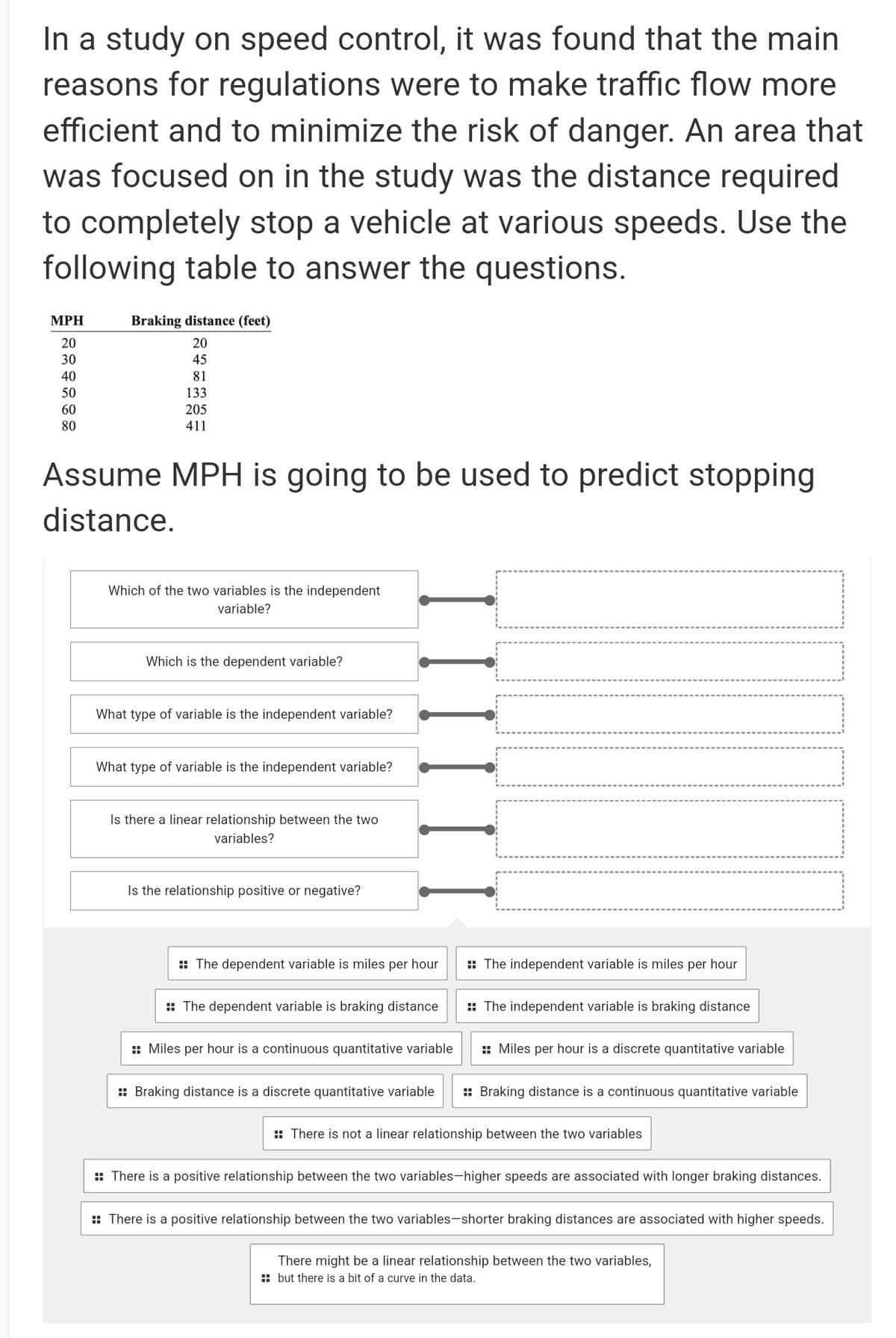In a study on speed control, it was found that the main reasons for regulations were to make traffic flow more efficient and to minimize the risk of danger. An area that was focused on in the study was the distance required to completely stop a vehicle at various speeds. Use the following table to answer the questions. МPH Braking distance (feet) 20 20 30 45 40 81 50 133 60 205 80 411 Assume MPH is going to be used to predict stopping distance. Which of the two variables is the independent variable? Which is the dependent variable? What type of variable is the independent variable? What type of variable is the independent variable? Is there a linear relationship between the two variables? Is the relationship positive or negative? : The dependent variable is miles per hour :: The independent variable is miles per hour : The dependent variable is braking distance : The independent variable is braking distance :: Miles per hour is a continuous quantitative variable :: Miles per hour is a discrete quantitative variable :: Braking distance is a discrete quantitative variable :: Braking distance is a continuous quantitative variable :: There is not a linear relationship between the two variables :: There is a positive relationship between the two variables-higher speeds are associated with longer braking distances. : There is a positive relationship between the two variables-shorter braking distances are associated with higher speeds. There might be a linear relationship between the two variables, :: but there is a bit of a curve in the data.
In a study on speed control, it was found that the main reasons for regulations were to make traffic flow more efficient and to minimize the risk of danger. An area that was focused on in the study was the distance required to completely stop a vehicle at various speeds. Use the following table to answer the questions. МPH Braking distance (feet) 20 20 30 45 40 81 50 133 60 205 80 411 Assume MPH is going to be used to predict stopping distance. Which of the two variables is the independent variable? Which is the dependent variable? What type of variable is the independent variable? What type of variable is the independent variable? Is there a linear relationship between the two variables? Is the relationship positive or negative? : The dependent variable is miles per hour :: The independent variable is miles per hour : The dependent variable is braking distance : The independent variable is braking distance :: Miles per hour is a continuous quantitative variable :: Miles per hour is a discrete quantitative variable :: Braking distance is a discrete quantitative variable :: Braking distance is a continuous quantitative variable :: There is not a linear relationship between the two variables :: There is a positive relationship between the two variables-higher speeds are associated with longer braking distances. : There is a positive relationship between the two variables-shorter braking distances are associated with higher speeds. There might be a linear relationship between the two variables, :: but there is a bit of a curve in the data.
Chapter6: Systems Of Equations And Inequalities
Section: Chapter Questions
Problem 17PS: Cholesterol Cholesterol in human blood is necessary, but too much can lead to health problems. There...
Related questions
Question

Transcribed Image Text:In a study on speed control, it was found that the main
reasons for regulations were to make traffic flow more
efficient and to minimize the risk of danger. An area that
was focused on in the study was the distance required
to completely stop a vehicle at various speeds. Use the
following table to answer the questions.
МPH
Braking distance (feet)
20
20
30
45
40
81
50
133
60
205
80
411
Assume MPH is going to be used to predict stopping
distance.
Which of the two variables is the independent
variable?
Which is the dependent variable?
What type of variable is the independent variable?
What type of variable is the independent variable?
Is there a linear relationship between the two
variables?
Is the relationship positive or negative?
:: The dependent variable is miles per hour
:: The independent variable is miles per hour
: The dependent variable is braking distance
: The independent variable is braking distance
:: Miles per hour is a continuous quantitative variable
:: Miles per hour is a discrete quantitative variable
:: Braking distance is a discrete quantitative variable
:: Braking distance is a continuous quantitative variable
:: There is not a linear relationship between the two variables
: There is a positive relationship between the two variables-higher speeds are associated with longer braking distances.
:: There is a positive relationship between the two variables-shorter braking distances are associated with higher speeds.
There might be a linear relationship between the two variables,
:: but there is a bit of a curve in the data.
Expert Solution
This question has been solved!
Explore an expertly crafted, step-by-step solution for a thorough understanding of key concepts.
This is a popular solution!
Trending now
This is a popular solution!
Step by step
Solved in 2 steps with 1 images

Recommended textbooks for you


Glencoe Algebra 1, Student Edition, 9780079039897…
Algebra
ISBN:
9780079039897
Author:
Carter
Publisher:
McGraw Hill

Holt Mcdougal Larson Pre-algebra: Student Edition…
Algebra
ISBN:
9780547587776
Author:
HOLT MCDOUGAL
Publisher:
HOLT MCDOUGAL


Glencoe Algebra 1, Student Edition, 9780079039897…
Algebra
ISBN:
9780079039897
Author:
Carter
Publisher:
McGraw Hill

Holt Mcdougal Larson Pre-algebra: Student Edition…
Algebra
ISBN:
9780547587776
Author:
HOLT MCDOUGAL
Publisher:
HOLT MCDOUGAL

Elementary Geometry For College Students, 7e
Geometry
ISBN:
9781337614085
Author:
Alexander, Daniel C.; Koeberlein, Geralyn M.
Publisher:
Cengage,

Big Ideas Math A Bridge To Success Algebra 1: Stu…
Algebra
ISBN:
9781680331141
Author:
HOUGHTON MIFFLIN HARCOURT
Publisher:
Houghton Mifflin Harcourt

Mathematics For Machine Technology
Advanced Math
ISBN:
9781337798310
Author:
Peterson, John.
Publisher:
Cengage Learning,